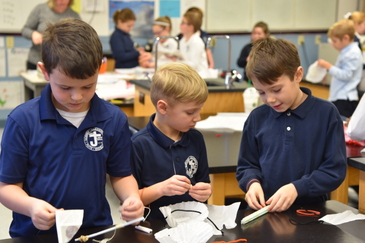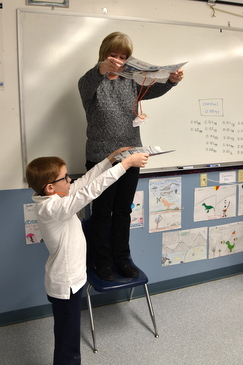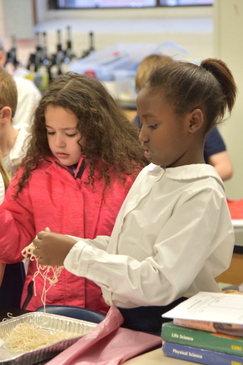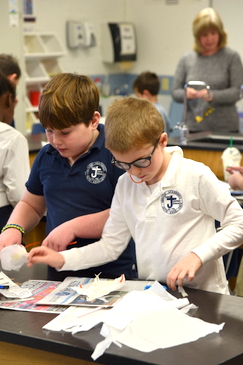STREAM Allows Creativity to Flow

“I want them to think differently,” says teacher Jennifer Lafrance. “I always say, ‘If I give you a plastic spoon, what can we do with it? O.k., we can eat with a spoon, but what else?’”
Lafrance teaches STREAM classes for kindergarten – Grade 5 students. STREAM is an acronym for science, technology, religion, engineering, art, and mathematics. Similar to the better-known STEM, but with the addition of religion and art, STREAM takes a creativity focused approach to teaching, which integrates several subjects.
“A big focus of it is to get that analytical, critical thinking piece, creativity, working with partners,” explains Lafrance. “It’s not about memorizing concepts. It’s about doing, having to interact with other people.”
In each STREAM class, students are presented with a problem to solve and given materials to do it. Second graders, for instance, had to help Jack find a way to flee the giant without using the beanstalk.
“Jack needs another plan of escape. That’s where you come in,” Lafrance told the students. “Your challenge: build a parachute to help Jack.”

Each pair of students got a piece of plastic, a piece of tissue, and a sheet of newspaper, along with their choice of six other items, which included string, straws, coffee filters, and pipe cleaners.
They didn’t hesitate.
“We’re making a parachute for a fairy tale called ‘Jack and the Beanstalk,’” says Chelsea, age 7. “Me and Julia, she’s making the down, and I’m making the up.”
“We have this little LEGO person, and I made a seat for him,” says Julia C., also age 7.
“It’s a straw that we used for a seat, and for the person to stay on there, we have pipe cleaners through the straw,” adds Chelsea.
“We were thinking that this was going to be the top,” says Cameron, age 8, pointing to some crumpled tissue. “Then, we realized this (newspaper) was bigger, so we used that as the top.”
“We added that to make it float better, because it’s airier,” explains Ethan, age 7, his partner.
“We used a coffee filter for the bottom, and we put two pipe cleaners on the top, and then a plastic bag,” says Julia B, age 7. “And we’re using some tissue to put at the top to make it heavier, so it will go down slower.

“It’s changing their whole mindset. The plasticity of the mind, that growth mindset instead of that fixed mindset, that’s what this class develops,” says Principal Nancy Naimey.
Lafrance, who was a research scientist and product developer for Tom’s of Maine before pursuing her passion for teaching, stresses how important that is.
“You can Google almost anything, but you need to know how to use it and apply it,” she says.
Lafrance enjoys coming up with different projects, seeking ones that incorporate several subjects. For instance, an oil spill project provided the opportunity to talk about care of our common home. The Jack and the Beanstalk challenge includes a discussion of Jack’s motives.
“Did Jack steal or did he not?” explains Chelsea. “If he were Jesus, he wouldn’t have stolen.
Students have created jump ropes out of plastic bags and duct tape. They created bird nests out of paper and string. Using Popsicle sticks, toilet paper, and paper plates they constructed a shelter that could withstand wind and rain, generated by a box fan and spray bottle. They have also learned coding and built circuits.
When it comes to materials, students never know what is going to show up.

Kindergarten – Grade 5 students attend a STREAM class once a week, and while it’s not part of the Grades 6-8 curriculum, Lafrance, who teaches middle school science, tries to incorporate elements of STREAM when possible.
It is popular with all the grades.
“It’s fun because we get to build stuff, and sometimes, we get to take it home, and sometimes, we even get to use LEGOs,” says Chelsea.
“I like building things,” says Ethan.
“We get to build a lot and bring these home,” says Cameron.
While it may seem like fun and games, Naimey says she has no doubts about the value of the course.
“I am convinced that there are jobs that are going to happen when they graduate that we don’t even know about,” she says. “These skills are 21st century skills that the kids really need to know.”










